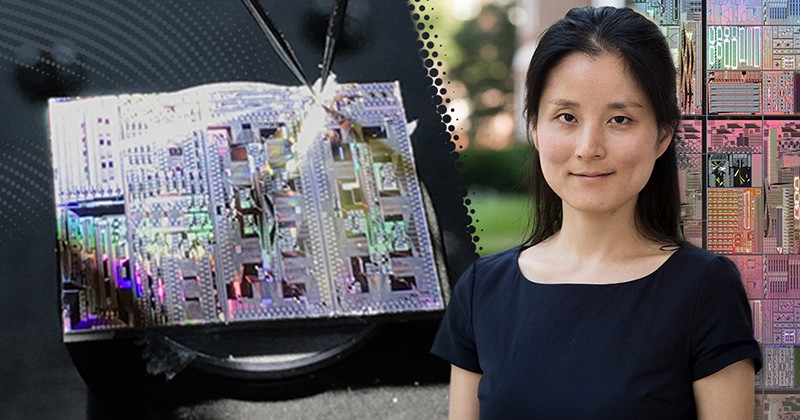UD Engineering’s Tingyi Gu, fellow researchers are creating state-of-the-art computing devices
On the third floor of the University of Delaware’s Du Pont Hall, electrical engineers analyze delicate, centimeter-sized computer chips on a large optical table surrounded by oscilloscopes, lenses and lasers. These researchers are busy collecting data on how well these chips can convert light waves into electrical signals, with the goal of figuring out how to make the next batch of chips they fabricate even faster, more energy efficient or with increased computing capabilities.
It’s here in the lab of Tingyi Gu, an assistant professor in the Department of Electrical and Computer Engineering, where researchers are pushing the limits of the field of integrated photonic devices. Using a high-risk, high-reward research strategy, Gu’s research group has made progress in developing new chip designs and applying unique materials for a wide range of optical communication, sensing and computing applications.
Light control
Photonic devices are ones that can create, control or detect light, and photonic integrated circuits are able to use light for even more complex functions such as data analysis. Gu, who began working in this field as a graduate student, is focused on improving photonic integrated circuits through fundamental research, with a focus on developing new chip designs and studying how materials from other applications could be incorporated into photonic devices.
“For me and my students, we’re less likely to read a paper and modify something to show a slightly better advantage. Instead, we try to find something that can be more revolutionary by trying to fundamentally change the way we’re doing it,” said Gu about her group’s research strategy. “This is a higher risk approach, but it’s more fun to explore that rather than try to repeat what others have done or make some incremental progress.”
Two examples of how Gu’s research strategy has led to progress in the field of photonics can be found in two of her group’s papers from earlier in 2022, one published in Nature Communications and the other in Advanced Materials.
Scaling up
In 2019, Gu and graduate student Zi Wang developed an on-chip transformative optics design principle for robust wavefront control on an integrated photonic platform, which can be used for complicated processes related to other areas such as quantum optics.
Now, the group’s latest Nature Communications paper demonstrates how advanced computing capabilities can be integrated directly onto these photonic chips. “In 2019, our device had very simple components, like Fourier transformation. Now, with nearly a thousand pre-programmed elements, the integrated metasystem can handle uncertainties across the spectral domains, which is a milestone of integrated photonic processors to its electronic counterpart,” said Gu.
Wang, who is now a postdoc at the National Institute of Standards and Technology (NIST), said that scaling up their original design, which would also make it compatible with manufacturing processes, was the most challenging part of this recent paper. “The structure was designed with a gradient back-propagation method, which cost a lot of time and computing resources in our original design,” said Wang. “But I found that our structure has a particular symmetry, and by using the symmetry in mathematical calculation, the computation became much easier.”

Members of the Gu lab after a group meeting at their laboratory in Evans Hall (from left, clockwise) postdoc Kaleem Ullah, doctoral student Masudur Rahim, doctoral student Dun Mao, visiting scholar Jongryul Kim, master’s student S M Zia Uddin, postdoc Heijun Jeong, visiting scholar Taharat Tazrin, doctoral student Yahui Xiao, and doctoral student Lorry Chang.
Thanks to this insight, the researchers discovered that they could use light diffraction to perform complex computations and data analyses. “And because each of the programmable components is much smaller than the conventional chips, you can pack many more in the same chip area,” said Gu.
Gu added that this paper is an example of how new design approaches can help researchers use existing fabrication methods to create chips that are more powerful than current state-of-the-art technologies. “There’s much greater potential for integrated photonic circuits, not just the same way that they have been used and studied for decades, and even current circuits now have limitations that we can break,” she said.
Making new (optical) memories
A second paper, published in Advanced Materials, demonstrates how Gu’s lab takes inspiration from materials in other applications to evaluate if they could be used for photonic memory, which rely on light instead of magnetism to store information.
Known as optical memristive devices, these platforms for rewritable memory storage have the potential to reduce overall energy consumption but currently rely on a slow process related to changes in the material’s phase, or the physical state of the material (the most common being solid, liquid and gas). Phase shifting is how optical devices store memory, but here the phase shifting process requires a transition between an amorphous phase (one that doesn’t have much structure, like a pile of sand grains) and a crystalline phase (one that is highly structured, like a close-up of a snowflake).
Creating a phase shifter for photonic integrated circuits that is both compact and controllable has remained a challenge because the materials currently available for optical devices only change phases very slowly and at extremely high temperatures.
In this paper, the group studied indium selenide (In2Se3), a material commonly used in electronic devices but that has not been widely incorporated in optical applications, to see if they could create optical memory by shifting between different crystalline phases instead of between crystalline and amorphous phases.
In this study, lead author Tiantian Li, a former UD postdoc who is now an associate professor at Xi’an University of Posts and Telecommunications, first discovered that the phase transition mechanism for indium selenide was different than originally theorized based on simulated results. The researchers then used these theoretical insights to phase shift between different crystalline states, creating optical memories using short, nanosecond light pulses.
“Optical phase change materials have attracted a lot of interest because of the promising application in optical computing,” said Li about the impacts of this work. “The high-power consumption of the phase change material influences the computing speed of the neural network, and our material promises to break this bottleneck.”

Researchers in Gu’s lab are focused on developing new chip designs and studying how materials from other applications could be incorporated into photonic devices. The work entails three phases: Simulation, where different chip designs are evaluated; fabrication, where the chips are made at UD’s Nanofabrication Facility; and testing, where chips are evaluated to see how well they perform compared to what was predicted by the simulation.
Beyond their applications for the field of photonics, these two papers also showcase the importance of creativity and unique sources of inspiration in this field. “We try to leverage other resources and combine knowledge from different areas,” said Gu. “In the Nature Communications paper, we were inspired by people doing image classifications for machine learning, and we brought that onto our integrated photonic platform, and for the Advanced Materials paper, we were inspired by chemists who study phase transition mechanisms.”
The future of photonics
Current members of the Gu lab are busy continuing the progress of these and other projects, all with a focus on improving the current state-of-the-art for photonic devices.
This innovative work entails three key yet challenging phases: Simulation, where different chip designs are evaluated using computer software; fabrication, where the actual chips are made at UD’s Nanofabrication Facility; and testing, where they bring the chips back to the lab to see how well they perform compared to what was predicted by the simulation.
For Yahui Xiao, a doctoral student working on photonic crystals, doing this type of research, which requires knowledge that stretches from fundamental physics to manufacturing, has provided her with a meaningful graduate school experience, especially since she looks forward to a career doing this type of “hybrid” research in optical engineering and nanophotonics.
“I’d like to gain insights of current technology by understanding the underlying physics,” she said. “Here at UD, we have the Nanofabrication Facility, and those fabrication skills are ones that we can use when we go to industry since we can do the entire fabrication process.”
Doctoral student Dun Mao, who is working on the indium selenide project, says that while research in this field can be challenging, it’s encouraging when they are able to make breakthroughs and get good results. “The most exciting part is when we observe some interesting phenomenon from our experiments that can make a device faster or more efficient,” he said.
Gu added that while there are many unanswered research questions in the field of photonics that their group could address, the work in her lab is always driven by her student’s interests and passions. “We try to take higher risk approaches in the lab, and sometimes it’s good, sometimes it’s not as good, but I think students learn a lot,” said Gu.
Both Mao and Xiao said that Gu’s support has been instrumental to their success in graduate school thus far, and Xiao added that having Gu as a woman mentor in a field that is typically male dominated has been additionally inspiring for her. “Dr. Gu is a really good example for me — I can learn a lot of things from her, she is really successful in this area, and with good projects, sponsors and connections. Overall, she has really encouraged me.”
The complete list of co-authors on the Nature Communications paper includes UD’s Zi Wang, Lorry Chang, Feifan Wang, Tiantian Li (now an associate professor at Xi’an University of Posts and Telecommunications) and Tingyi Gu.
The complete list of co-authors on the Advanced Materials paper includes Chris J. Benmore and Ganesh Sivaraman from Argonne National Laboratory and UD’s Tiantian Li (now an associate professor at Xi’an University of Posts and Telecommunications), Yong Wang, Wei Li, Dun Mao, Igor Evangelista, Huadan Xing, Qiu Li, Feifan Wang, Anderson Janotti, Stephanie Law and Tingyi Gu.
| Photos by Evan Krape, courtesy of Tingyi Gu | Illustrations by Joy Smoker | December 12, 2022




